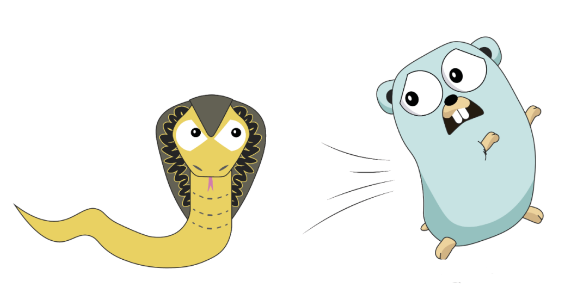
Cobra 是 Golang 生态系统中最着名的项目之一。它简单,高效,并得到 Go 社区的大力支持。让我们来深入探索一下。
设计
Cobra 中的 Command 是一个具有名称,使用描述和运行逻辑函数的结构体:
cmd := &cobra.Command{
Run: runGreet,
Use: `greet`,
Short: "Greet",
Long: "This command will print Hello World",
}
设计非常类似于原生的 go 标准库命令,如 go env,go fmt等
比如,go fmt 命令结构:
var CmdFmt = &base.Command{ Run: runFmt, UsageLine: "go fmt [-n] [-x] [packages]", Short: "gofmt (reformat) package sources", Long: ` Fmt runs the command 'gofmt -l -w' on the packages named by the import paths. It prints the names of the files that are modified. For more about gofmt, see 'go doc cmd/gofmt'. For more about specifying packages, see 'go help packages'. The -n flag prints commands that would be executed. The -x flag prints commands as they are executed. To run gofmt with specific options, run gofmt itself. See also: go fix, go vet. `, }
如果你熟悉了 Cobra,很容易理解内部命令是如何工作的,反之亦然。我们可能会想,当 Go 已经定义了命令接口后,为什么还要要使用外部库?
Go 标准库定义的接口:
type Command struct { // Run 运行命令. // 参数在命令之后 Run func(cmd *Command, args []string) // UsageLine 是一行描述信息. // 其中第一个词语应是命令. UsageLine string // Short 是 'go help' 输出的简单描述. Short string // Long 是 'go help <this-command>' 输出的详细描述. Long string // Flag 一组特定于此命令的标志码. Flag flag.FlagSet // CustomFlags 表示了命令将执行自定义的标志解析 CustomFlags bool // Commands 列举可用的命令和 help 主题. // 顺序和 'go help' 输出一致. // 注意:通常最好避免使用子命令. Commands []*Command }
此接口是仅适用于标准库的内部包的一部分。在 2014 年 6 月的 Go 1.4 版本中,Russ Cox 提出了 限制使用内部包和命令的建议。基于此内部包构建命令会带来错误:
package main import ( "cmd/go/internal/base" ) func main() { cmd := &base.Command{ Run: func(cmd *base.Command, args []string) { println(`Hello`) }, Short: `Hello`, } cmd.Run(cmd, []string{}) }
main.go:4:2: use of internal package cmd/go/internal/base not allowed
然而,正如 Cobra 创建者 Steve Francia所解释的那样:这个内部界面设计 催生了了 Cobra(Steve Franci 在 Google 工作并曾直接参与了 Go 项目。)。
该项目也建立在来自同一作者的 pflag 项目之上,提供符合 POSIX 标准。因此,程序包支持短标记和长标记,如-e替代--example ,或者多个选项,如-abc 和-a,-b 和-c 都是是有效选项。这旨在改进 Go 库中的 flag 包,该库仅支持标志-xxx。
特性
Cobra 有一些值得了解的简便方法:
- Cobra 提供了两种方法来运行我们的逻辑:Run func(cmd *Command, args []string) 和 RunE func(cmd *Command, args []string) error ,后者可以返回一个错误,我们将能够从 Execute() 方法的返回中捕获。
- Command 结构 提供了一个 Aliases(别名) 属性,允许我们将命令迁移到一个新名称,而不需要在alias属性中通过映射旧名称来破坏现有的行为。这种兼容性策略甚至可以通过使用 Deprecated 属性来增强,该属性允许您将一个命令标记为Deprecated(即将弃用,不推荐使用),并在删除它之前提供一个简短的说明。
- 由于每个命令都可以嵌入其他命令,因此 Cobra 本身支持嵌套命令,并允许我们像下边这样编写:
go run main.go foo bar
在这里, foo 是命令,bar 是嵌套命令:
package main import ( "github.com/spf13/cobra" ) func main() { cmd := newCommand() // 构建一般命令 cmd.AddCommand(newNestedCommand()) // 加入嵌套命令 rootCmd := &cobra.Command{} rootCmd.AddCommand(cmd) if err := rootCmd.Execute(); err != nil { println(err.Error()) } } func newCommand() *cobra.Command { cmd := &cobra.Command{ Run: func (cmd *cobra.Command, args []string) { println(`Foo`) }, Use: `foo`, Short: "Command foo", Long: "This is a command", } return cmd } func newNestedCommand() *cobra.Command { cmd := &cobra.Command{ Run: func (cmd *cobra.Command, args []string) { println(`Bar`) }, Use: `bar`, Short: "Command bar", Long: "This is a nested command", } return cmd }
可以使用嵌套命令是 决定构建 Cobra的主要动机之一
轻量
这个库的代码主要包含一个文件,而且很好理解,它不会影响你程序的性能。接下来,我们做一个压力测试(benchmark):
package main import ( "github.com/spf13/cobra" "math/rand" "os" "strconv" "testing" ) func BenchmarkCmd(b *testing.B) { for i := 0; i < b.N; i++ { root := &cobra.Command{ Run: func(cmd *cobra.Command, args []string) { println(`main`) }, Use: `test`, Short: "test", } max := 100 for c := 0; c < max; c++ { cmd := &cobra.Command{ Run: func(cmd *cobra.Command, args []string) { _ = c }, Use: `test-`+strconv.Itoa(c), Short: `test `+strconv.Itoa(c), } root.AddCommand(cmd) } r := rand.Intn(max) os.Args = []string{"go", "test-"+strconv.Itoa(r)} _ = root.Execute() } }
Cobra 运行 50 条命令只有 49.0μs 负载:
name time/op Cmd-8 49.0µs ± 1% name alloc/op Cmd-8 78.3kB ± 0% name allocs/op Cmd-8 646 ± 0%
由于 Cobra 被设计运行在 CLI 模式下, 性能并不重要, 但是可以看出这个库有多么轻量.
可替代性
即使 Cobra 倾向于成为 Go 社区的标准包 - 浏览最近使用 Cobra 的项目证实了这一点 - 了解 Go 生态系统中有关 CLI 接口的内容总是好的。
让我们回顾两个可以替代 Cobra 的项目:
- cli,一个用于构建命令行应用程序的包。这个包和 Cobra 一样流行,与嵌套命令,bash 补全,hook(钩子),alias(别名)等非常相似。但是,与 Cobra 不同,这个包使用 Go 库中的原生flag包。
urfave/cli 例子:
package main import ( "log" "os" "github.com/urfave/cli" ) func main() { app := cli.NewApp() app.Commands = []cli.Command{ { Action: func(c *cli.Context) error { println("Hello world") return nil }, Name: `greet`, Usage: "This command will print Hello World", }, } err := app.Run(os.Args) if err != nil { log.Fatal(err) } }
- subcommands:虽然托管在 Google 的 Github 帐户中,但该项目并非官方 Google 产品。该库也很简单
google/subcommands 示例
package main import ( "context" "flag" "github.com/google/subcommands" ) type GreetCommand struct {} func (g *GreetCommand) Name() string { return "greet" } func (g *GreetCommand) Synopsis() string { return "Greet the world." } func (g *GreetCommand) Usage() string { return `Print Hello World.` } func (g *GreetCommand) SetFlags(*flag.FlagSet) {} func (p *GreetCommand) Execute(ctx context.Context, f *flag.FlagSet, _ ...interface{}) subcommands.ExitStatus { println(`Hello World`) return subcommands.ExitSuccess } func main() { subcommands.Register(&GreetCommand{}, "foo") flag.Parse() subcommands.Execute(context.Background()) }
如我们之前看到的 Cobra 或 CLI,该库基于一个接口而不是一个结构体,因此并使代码稍显冗长。
扫码二维码 获取免费视频学习资料

- 本文固定链接: http://www.phpxs.com/post/7261/
- 转载请注明:转载必须在正文中标注并保留原文链接
- 扫码: 扫上方二维码获取免费视频资料

